Podcast: Play in new window | Download
Subscribe: Apple Podcasts | RSS
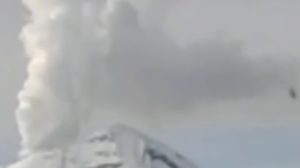 The date was Monday, June 9, 2014 and the time was 8:19 am. Mexico was waking up, and thousands of Mexicans were tuned into the Televisa network’s morning program on channel 4 called El Mañanero. The show is typical of morning shows throughout the world with news and current events mixed with human interest stories to give people a light start to their day. On that Monday, however, the lighthearted morning show would take an interesting and unexpected twist. Glancing up over their breakfast or morning coffee, tens of thousands of viewers would report seeing something curious going on behind the show’s announcer. As a background, El Mañanero had live footage of Popocatépetl, Mexico’s most active volcano, which had been spewing ash and smoke into the air intermittently since early 2012. From out of the plumes of smoke, as viewers would call in to report, a black object emerged. It hovered for a while and then moved off the screen to the right. The handsome young announcer did not even know what was going on in the screen behind him and continued reporting the news. When the calls started to come in about this black UFO emerging from the volcano, researchers were quick to try to verify the sighting by other means. A popular web site called “webcamsdemexico” had a 24-hour camera fixed on Popocatépetl from the town of Santiago Xalizintla in the Mexican state of Puebla. From a different angle, the camera caught the same black object emerging from the volcano at the same exact time as what the viewers saw on the El Mañanero show. This was not the first or the last time that strange objects have been seen either coming out of or hovering around Mexico’s iconic volcanoes. In addition to many UFOs reported in and around the volcanic zones, witnesses have also reported the appearance of strange humanoids which may or may not be related to what people are seeing in the skies.
The date was Monday, June 9, 2014 and the time was 8:19 am. Mexico was waking up, and thousands of Mexicans were tuned into the Televisa network’s morning program on channel 4 called El Mañanero. The show is typical of morning shows throughout the world with news and current events mixed with human interest stories to give people a light start to their day. On that Monday, however, the lighthearted morning show would take an interesting and unexpected twist. Glancing up over their breakfast or morning coffee, tens of thousands of viewers would report seeing something curious going on behind the show’s announcer. As a background, El Mañanero had live footage of Popocatépetl, Mexico’s most active volcano, which had been spewing ash and smoke into the air intermittently since early 2012. From out of the plumes of smoke, as viewers would call in to report, a black object emerged. It hovered for a while and then moved off the screen to the right. The handsome young announcer did not even know what was going on in the screen behind him and continued reporting the news. When the calls started to come in about this black UFO emerging from the volcano, researchers were quick to try to verify the sighting by other means. A popular web site called “webcamsdemexico” had a 24-hour camera fixed on Popocatépetl from the town of Santiago Xalizintla in the Mexican state of Puebla. From a different angle, the camera caught the same black object emerging from the volcano at the same exact time as what the viewers saw on the El Mañanero show. This was not the first or the last time that strange objects have been seen either coming out of or hovering around Mexico’s iconic volcanoes. In addition to many UFOs reported in and around the volcanic zones, witnesses have also reported the appearance of strange humanoids which may or may not be related to what people are seeing in the skies.
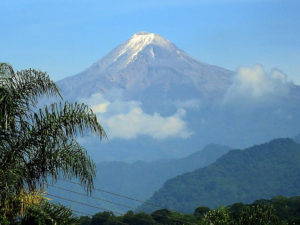 Unknown to many non-Mexicans, Mexico is home to five volcanoes that stand over 15,000 feet tall. The tallest among them at 18,491 feet is Pico de Orizaba, also known by its indigenous name, Citlaltépetl, and is the second-highest volcano in the world after Mount Kilimanjaro in Africa. The next in order of height at 17,802 feet is Popocatépetl, the famous mountain which looms in the distance and is quite visible from Mexico City. In modern times this peak has been in various states of eruption, mostly an annoyance and mild curiosity to the tens of millions of people who live in sight of it. Of all the 15,000+ tall volcanoes in Mexico, Popocatépetl is the only one classified as “active.” The next highest mountain in Mexico, also a volcano, is Iztaccihuatl, which in the indigenous language means “White Woman.” Early Spanish-speaking inhabitants of the area nicknamed the volcano “La Mujer Dormida,” or “The Sleeping Woman,” because of its resemblance to a reclining female in silhouette. According to Aztec legend, Iztaccihuatl was once a princess who fell in love with one of her father’s warriors named Popocatépetl. In a sort of Romeo and Juliet fashion, with a distinctive Mesoamerican twist, when the princess heard the false news that the warrior had been killed in a battle in Oaxaca, she died of grief. When Popocatépetl returned home to find that his love had died, the gods covered them both with snow and turned them
Unknown to many non-Mexicans, Mexico is home to five volcanoes that stand over 15,000 feet tall. The tallest among them at 18,491 feet is Pico de Orizaba, also known by its indigenous name, Citlaltépetl, and is the second-highest volcano in the world after Mount Kilimanjaro in Africa. The next in order of height at 17,802 feet is Popocatépetl, the famous mountain which looms in the distance and is quite visible from Mexico City. In modern times this peak has been in various states of eruption, mostly an annoyance and mild curiosity to the tens of millions of people who live in sight of it. Of all the 15,000+ tall volcanoes in Mexico, Popocatépetl is the only one classified as “active.” The next highest mountain in Mexico, also a volcano, is Iztaccihuatl, which in the indigenous language means “White Woman.” Early Spanish-speaking inhabitants of the area nicknamed the volcano “La Mujer Dormida,” or “The Sleeping Woman,” because of its resemblance to a reclining female in silhouette. According to Aztec legend, Iztaccihuatl was once a princess who fell in love with one of her father’s warriors named Popocatépetl. In a sort of Romeo and Juliet fashion, with a distinctive Mesoamerican twist, when the princess heard the false news that the warrior had been killed in a battle in Oaxaca, she died of grief. When Popocatépetl returned home to find that his love had died, the gods covered them both with snow and turned them 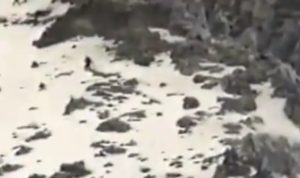 into mountains. As the volcano Iztaccihuatl is 17,160 feet tall, it is perpetually snow-capped. In fact, the other two taller volcanoes previously mentioned also have glaciers on them, which is a surprising piece of trivia for foreigners who tend to think of Mexico in terms of beach resorts, harsh deserts and steamy jungles full of undiscovered ruins. The highest peaks in Mexico all have alpine rescue teams attached to them, much like what they have in places such as Switzerland, which are comprised of highly trained individuals who are skilled in harsh terrain and cold weather rescues. The last two volcanoes in Mexico that are above 15,000 feet are Nevado de Toluca, also called Xinantécatl which stands at 15,350 feet, and Sierra Negra, also called Atlitzin, which stands at 15,223 feet and is located right next to the tallest peak, Pico de Orizaba, on the border of the Mexican states of Puebla and Veracruz. All volcanoes mentioned are located in the central part of the country in what geologists call the Trans-Mexican Volcanic Belt. All volcanoes have strange phenomena associated with them, including strange lights and objects in the sky, and mysterious beings seen by hikers in inaccessible areas.
into mountains. As the volcano Iztaccihuatl is 17,160 feet tall, it is perpetually snow-capped. In fact, the other two taller volcanoes previously mentioned also have glaciers on them, which is a surprising piece of trivia for foreigners who tend to think of Mexico in terms of beach resorts, harsh deserts and steamy jungles full of undiscovered ruins. The highest peaks in Mexico all have alpine rescue teams attached to them, much like what they have in places such as Switzerland, which are comprised of highly trained individuals who are skilled in harsh terrain and cold weather rescues. The last two volcanoes in Mexico that are above 15,000 feet are Nevado de Toluca, also called Xinantécatl which stands at 15,350 feet, and Sierra Negra, also called Atlitzin, which stands at 15,223 feet and is located right next to the tallest peak, Pico de Orizaba, on the border of the Mexican states of Puebla and Veracruz. All volcanoes mentioned are located in the central part of the country in what geologists call the Trans-Mexican Volcanic Belt. All volcanoes have strange phenomena associated with them, including strange lights and objects in the sky, and mysterious beings seen by hikers in inaccessible areas.
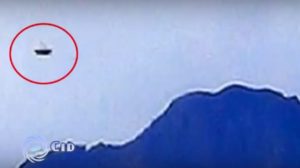 A simple online search of “OVNI,” which is Spanish for “UFO,” along with any of the peaks listed here will get a whole host of articles and video clips of unknown flying objects in and around the volcanoes. As nearly everyone in Mexico now has a camera attached to their mobile phones, footage of unexplained objects in the sky are more and more common. Knowing that the volcanoes are hotspots for UFO activity, some researchers have come up with interesting nighttime footage by using infrared cameras. The most common objects filmed in conjunction with the great volcanoes are orbs, discs, cylindrical objects and a strange phenomenon of what appears to be flying humanoids. We will return to the humanoids later and will now focus on the more traditional UFOs. On January 4, 2014 inside the caldera of Nevado de Toluca, a hiker recorded a greenish yellow orb emerging out of one of the small lakes inside the volcano. At first the hiker thought it was a duck or a goose, but the object assumed a spherical form and seemed to float along the surface of the lake and then among the boulders and rocks of the inside of the volcano. The object never left the caldera and went back into the lake. The lakes inside Nevado de Toluca are said to be the home of the tlanchana, a fresh-water mermaid type creature that pre-dates the Aztecs. To learn more about the tlanchana, please check out Mexico Unexplained episode #47. The orbs, either metallic or made of a bright, glowing light, are the most common UFOs sighted over all of the volcanoes in central Mexico. Next on the list are metallic, saucer-like objects. On February 6, 2016 a driver on a main highway passing by Pico de Orizaba took a picture of a disc-shaped object that made national television. When the photo was analyzed, it was judged not to be an enhancement or fake, and the object appeared to be as large as a commercial airliner. A glowing cylindrical object was filmed on December 2, 2012 in the skies above the snowy white Iztaccihuatl which was also witnessed by hundreds of people in the area. The most famous cylindrical UFO was captured by webcams de Mexico over Popocatépetl earlier that year, on October 25, and was seen disappearing inside the volcano and never coming out.
A simple online search of “OVNI,” which is Spanish for “UFO,” along with any of the peaks listed here will get a whole host of articles and video clips of unknown flying objects in and around the volcanoes. As nearly everyone in Mexico now has a camera attached to their mobile phones, footage of unexplained objects in the sky are more and more common. Knowing that the volcanoes are hotspots for UFO activity, some researchers have come up with interesting nighttime footage by using infrared cameras. The most common objects filmed in conjunction with the great volcanoes are orbs, discs, cylindrical objects and a strange phenomenon of what appears to be flying humanoids. We will return to the humanoids later and will now focus on the more traditional UFOs. On January 4, 2014 inside the caldera of Nevado de Toluca, a hiker recorded a greenish yellow orb emerging out of one of the small lakes inside the volcano. At first the hiker thought it was a duck or a goose, but the object assumed a spherical form and seemed to float along the surface of the lake and then among the boulders and rocks of the inside of the volcano. The object never left the caldera and went back into the lake. The lakes inside Nevado de Toluca are said to be the home of the tlanchana, a fresh-water mermaid type creature that pre-dates the Aztecs. To learn more about the tlanchana, please check out Mexico Unexplained episode #47. The orbs, either metallic or made of a bright, glowing light, are the most common UFOs sighted over all of the volcanoes in central Mexico. Next on the list are metallic, saucer-like objects. On February 6, 2016 a driver on a main highway passing by Pico de Orizaba took a picture of a disc-shaped object that made national television. When the photo was analyzed, it was judged not to be an enhancement or fake, and the object appeared to be as large as a commercial airliner. A glowing cylindrical object was filmed on December 2, 2012 in the skies above the snowy white Iztaccihuatl which was also witnessed by hundreds of people in the area. The most famous cylindrical UFO was captured by webcams de Mexico over Popocatépetl earlier that year, on October 25, and was seen disappearing inside the volcano and never coming out.
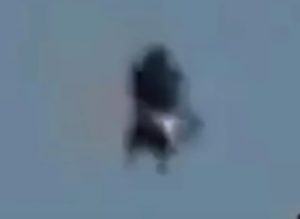 The active volcano Popocatépetl deserves special examination, not only because there seems to be more activity around it, but it is the only peak on which strange humanoids have been observed both on the ground and flying in the air. The paranormal Mexican television show Tercer Milenio hosted by investigative journalist Jaime Maussan, boasts that it has been reporting on flying humanoids spotted near the slopes of Popocatépetl since 1999. There are many video clips of strange, dark human-like figures floating around in the air in a seated or standing position. Some look like they are wearing jet packs. In Tepoztlan, in the Mexican state of Morelos, located between the Nevado de Toluca and Popocatépetl volcanoes, Gerardo Valenzuela recorded what looked like a standing man in black hovering over his town. This was July 8, 2000. Five years later, on June 17, 2005, Horacio Roquett filmed a flying humanoid in a seated position over southeastern Mexico City. The most famous flying humanoid footage was taken by amateur skywatcher Salvador Ramirez in the neighborhood called Tablas del Pozo in the town of Ecatepec on December 17, 2014 in the middle of the afternoon. Ramirez stated that the object had “intelligent movements” and in his footage it is clear that the figure has a pair of dangling legs.
The active volcano Popocatépetl deserves special examination, not only because there seems to be more activity around it, but it is the only peak on which strange humanoids have been observed both on the ground and flying in the air. The paranormal Mexican television show Tercer Milenio hosted by investigative journalist Jaime Maussan, boasts that it has been reporting on flying humanoids spotted near the slopes of Popocatépetl since 1999. There are many video clips of strange, dark human-like figures floating around in the air in a seated or standing position. Some look like they are wearing jet packs. In Tepoztlan, in the Mexican state of Morelos, located between the Nevado de Toluca and Popocatépetl volcanoes, Gerardo Valenzuela recorded what looked like a standing man in black hovering over his town. This was July 8, 2000. Five years later, on June 17, 2005, Horacio Roquett filmed a flying humanoid in a seated position over southeastern Mexico City. The most famous flying humanoid footage was taken by amateur skywatcher Salvador Ramirez in the neighborhood called Tablas del Pozo in the town of Ecatepec on December 17, 2014 in the middle of the afternoon. Ramirez stated that the object had “intelligent movements” and in his footage it is clear that the figure has a pair of dangling legs.
The humanoids seen on the ground on the slopes of the volcano Popocatépetl may or may not be related to the unidentified objects or human figures in the air, but many researchers believe they are. According to Agustín Tagle, the director of the national park that encompasses both Popcatépetl and Iztaccihuatl, many hikers have seen human-like creatures on the slopes of the volcanoes for years. The creatures are described as thin, and very tall, ranging from 7 to 8 feet in height. They are the color of the volcanic soil and move rapidly among the landscape. Some researchers claim that these beings are the same as those reported in Chile on the slopes of a volcano called Misti, a sort of bigfoot-like creature covered in hair called El Macon by the locals in Chile. Mexico has its own version of bigfoot called the Sisimite which supposedly lives in the jungles in the southern part of the country and has been described by the indigenous for thousands of years. For more information on the Sisimite, please see Mexico Unexplained episode #12. 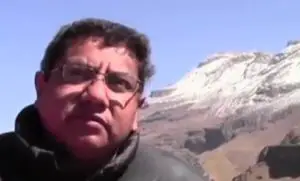 The tall hairy beings spotted on the slopes of Popocatépetl are said to be a recent phenomenon with no mentioning in indigenous lore and only date back a few decades, which have led some to believe that the creatures are not native to the area and are more recent arrivals. Famous Mexican mountaineer Guillermo Vidales described on camera his encounters with the creatures on the icy slopes of the volcano. He said he was in the Las Grietas area of the mountain on the route to the top of the crater when he saw a tall, thin, brown human-looking being scale the side of the volcano at a very rapid pace. The creature did not wear any equipment, which was strange in such extreme weather. The next day, Vidales and members of his hiking team found tracks in the snow. The footprints had what appeared to be indentations of a claw coming from the back of the leg, which probably assisted the being in climbing, much like a hiker’s crampon. On September 15, 2014 acclaimed Mexican UFO researcher Ana Luisa Cid interviewed a man named José Antonio Cisneros about his recent experiences on the slopes of Popocatépetl. Cisneros claimed that there are two types of unknown beings that live on the volcano, a smaller being that is mostly white with large black eyes which serves as a sort of custodian to the forest, an elemental being, much like the Chaneque of Aztec myths and legends. For more information about chaneques, please see Mexico Unexplained episode #59. Cisneros also claimed to have contact with the taller, thin beings reported by many other hikers in the past 20 years. Cisneros told Ana Luisa Cid that he believed that the taller, thinner humanoid creatures are part of the UFO phenomenon and they come directly from extraterrestrial craft.
The tall hairy beings spotted on the slopes of Popocatépetl are said to be a recent phenomenon with no mentioning in indigenous lore and only date back a few decades, which have led some to believe that the creatures are not native to the area and are more recent arrivals. Famous Mexican mountaineer Guillermo Vidales described on camera his encounters with the creatures on the icy slopes of the volcano. He said he was in the Las Grietas area of the mountain on the route to the top of the crater when he saw a tall, thin, brown human-looking being scale the side of the volcano at a very rapid pace. The creature did not wear any equipment, which was strange in such extreme weather. The next day, Vidales and members of his hiking team found tracks in the snow. The footprints had what appeared to be indentations of a claw coming from the back of the leg, which probably assisted the being in climbing, much like a hiker’s crampon. On September 15, 2014 acclaimed Mexican UFO researcher Ana Luisa Cid interviewed a man named José Antonio Cisneros about his recent experiences on the slopes of Popocatépetl. Cisneros claimed that there are two types of unknown beings that live on the volcano, a smaller being that is mostly white with large black eyes which serves as a sort of custodian to the forest, an elemental being, much like the Chaneque of Aztec myths and legends. For more information about chaneques, please see Mexico Unexplained episode #59. Cisneros also claimed to have contact with the taller, thin beings reported by many other hikers in the past 20 years. Cisneros told Ana Luisa Cid that he believed that the taller, thinner humanoid creatures are part of the UFO phenomenon and they come directly from extraterrestrial craft.
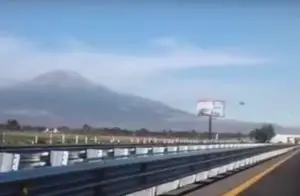 So why such high strangeness surrounding the Mexican volcanoes? There seems to be as many theories as there are researchers on the topics discussed. Some believe that the sightings on the web cams and infrared devices are easily explained away as lights from helicopters and other aircraft, or even celestial bodies like the moon or Venus. The hard core skeptics claim that photos or film footage showing UFOs are just elaborate hoaxes or innocent tricks of light. UFO and paranormal researchers who believe that the objects and beings associated with them have more extraterrestrial explanations theorize several things with regard to the volcanoes. The volcanoes may serve as portals to secret underground ET bases. The volcanoes may also be the source for raw materials to fuel interstellar spacecraft or to serve other purposes. The humanoids are explained as being scouts or part of earthly reconnaissance missions. Whatever the explanations, the sightings of strange objects in the sky and strange creatures on the ground in and around the famous Mexican volcanoes seem to be increasing over time. As with many mysteries, perhaps time will tell.
So why such high strangeness surrounding the Mexican volcanoes? There seems to be as many theories as there are researchers on the topics discussed. Some believe that the sightings on the web cams and infrared devices are easily explained away as lights from helicopters and other aircraft, or even celestial bodies like the moon or Venus. The hard core skeptics claim that photos or film footage showing UFOs are just elaborate hoaxes or innocent tricks of light. UFO and paranormal researchers who believe that the objects and beings associated with them have more extraterrestrial explanations theorize several things with regard to the volcanoes. The volcanoes may serve as portals to secret underground ET bases. The volcanoes may also be the source for raw materials to fuel interstellar spacecraft or to serve other purposes. The humanoids are explained as being scouts or part of earthly reconnaissance missions. Whatever the explanations, the sightings of strange objects in the sky and strange creatures on the ground in and around the famous Mexican volcanoes seem to be increasing over time. As with many mysteries, perhaps time will tell.
REFERENCES
The following web sites:
Tercer Milenio
Ana Luisa Cid’s UFO Investigations
CICAC
YouTube
